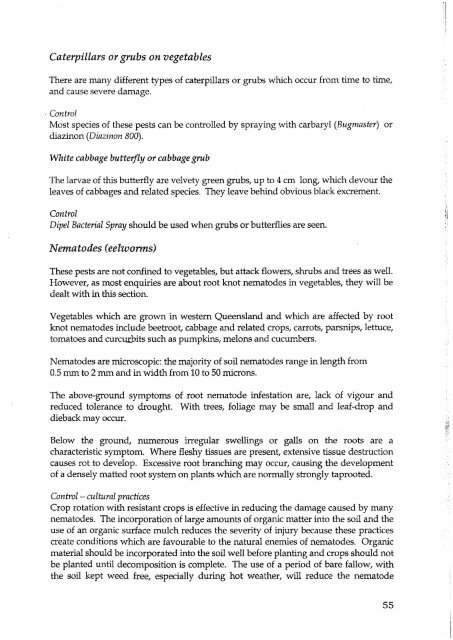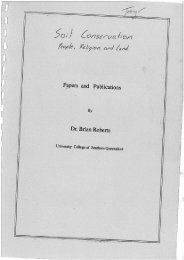western-queensland-gardening-guide.pdf - South West NRM
western-queensland-gardening-guide.pdf - South West NRM
western-queensland-gardening-guide.pdf - South West NRM
You also want an ePaper? Increase the reach of your titles
YUMPU automatically turns print PDFs into web optimized ePapers that Google loves.
Caterpillars or grubs on vegetables<br />
There are many different types of caterpillars or grubs whch occur from time to time,<br />
and cause severe damage.<br />
Control<br />
Most species of these pests can be controlled by spraying with carbaryl (Bugmaster) or<br />
diazinon (Diazinon 800).<br />
White cabbage butterfly or cabbage grub<br />
The larvae of this butterfly are velvety green grubs, up to 4 cm long, which devour the<br />
leaves of cabbages and related species. They leave belund obvious black excrement.<br />
Control<br />
Dipel Bacterial Spray should be used when grubs or butterflies are seen.<br />
Nematodes (eelwo<br />
These pests are not confined to vegetables, but attack flowers, shrubs and trees as well.<br />
However, as most enquiries are about root knot nematodes in vegetables, they will be<br />
dealt with in this section.<br />
Vegetables which are grown in <strong>western</strong> Queensland and which are affected by root<br />
knot nematodes include beetroot, cabbage and related crops, carrots, parsnips, lettuce,<br />
tomatoes and curcurbits such as pumpkins, melons and cucumbers.<br />
Nematodes are microscopic: the majority of soil nematodes range in length from<br />
0.5 mm to 2 mm and in width hom 10 to 50 microns.<br />
The above-ground symptoms of root nematode infestation are, lack of vigour and<br />
reduced tolerance to drought. With trees, foliage may be small and leaf-drop and<br />
dieback may occur.<br />
Below the ground, numerous irregular swellings or galls on the roots are a<br />
characteristic symptom. ere fleshy tissues are present, extensive tissue destruction<br />
causes rot to develop. Excessive root branching may occur, causing the development<br />
of a densely matted root system on plants which are normally strongly taprooted.<br />
Control - cultural practices<br />
Crop rotation with resistant crops is effective in reducing the damage caused by many<br />
nematodes. The incorporation of large amounts of organic matter into the soil and the<br />
use of an organic surface mulch reduces the severity of injury because these practices<br />
create conditions which are favourable to the natural enemies of nematodes. Organic<br />
material should be incorporated into the soil well before planting and crops should not<br />
be planted until decomposition is complete. The use of a period of bare fallow, with<br />
the soil kept weed free, especially during hot weather, will reduce the nematode
















